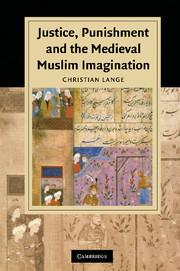Book contents
- Frontmatter
- Contents
- Acknowledgments
- List of abbreviations
- Introduction
- PART I THE POLITICS OF PUNISHMENT
- 1 Spheres and institutions of punishment
- 2 Types of punishment
- PART II THE ESCHATOLOGY OF PUNISHMENT
- PART III LEGAL DIMENSIONS OF PUNISHMENT
- Conclusion
- Bibliography
- Index of names
- Index of subjects
- Cambridge Studies in Islamic Civilization
1 - Spheres and institutions of punishment
Published online by Cambridge University Press: 21 July 2009
- Frontmatter
- Contents
- Acknowledgments
- List of abbreviations
- Introduction
- PART I THE POLITICS OF PUNISHMENT
- 1 Spheres and institutions of punishment
- 2 Types of punishment
- PART II THE ESCHATOLOGY OF PUNISHMENT
- PART III LEGAL DIMENSIONS OF PUNISHMENT
- Conclusion
- Bibliography
- Index of names
- Index of subjects
- Cambridge Studies in Islamic Civilization
Summary
Private punishments
Punishment is a broad concept that refers to a variety of social practices. One way to break down the complexity of this category is to distinguish between different spatial settings, or spheres, of punishment. The Saljūq state punished in three such spheres. The first sphere in which punishment was enacted was that of the ruler's private habitat, that is, the court and inside the palaces. Second, there was the semi-private, semi-official setting of the ruler's criminal and military tribunals. Finally, a third sphere of punishment constituted the public arena of the city.
A great number of cases are recorded in chronicles of the Saljūq period in which the ruler or his representative put to death other members of the ruling classes within the inner confines of the palace. Take the example of ʿAmīd al-Dawla Muḥammad b. Jahīr, vizier to the caliph Mustaẓhir (r. 487/1094–512/1118). During his career, ʿAmīd al-Dawla had been a highly esteemed government official. However, he had become an archenemy of Abū l-Maḥāsin, the vizier of the Saljūq sulṭān Barkyārūq (r. 485/1092–498/1105), since he had attempted to have Abū l-Maḥāsin assassinated a number of times. When in the year 493/1100 Abū l-Maḥāsin occupied Baghdad with his forces, ʿAmīd al-Dawla was arrested and imprisoned inside (fī bāṭin) the caliph's palace. A month later, he was brought out dead, carried to his house, washed there, and buried in a tomb that he had renovated in the quarter of Qarāḥ b. Razī.
- Type
- Chapter
- Information
- Justice, Punishment and the Medieval Muslim Imagination , pp. 25 - 60Publisher: Cambridge University PressPrint publication year: 2008



